Curl (mathematics)
In vector calculus, the curl is a vector operator that describes the infinitesimal rotation of a vector field in three-dimensional Euclidean space. At every point in the field, the curl of that point is represented by a vector. The attributes of this vector (length and direction) characterize the rotation at that point.
| Part of a series of articles about | ||||||
| Calculus | ||||||
|---|---|---|---|---|---|---|
 | ||||||
|
||||||
|
||||||
|
||||||
|
Specialized |
||||||
The direction of the curl is the axis of rotation, as determined by the right-hand rule, and the magnitude of the curl is the magnitude of rotation. If the vector field represents the flow velocity of a moving fluid, then the curl is the circulation density of the fluid. A vector field whose curl is zero is called irrotational. The curl is a form of differentiation for vector fields. The corresponding form of the fundamental theorem of calculus is Stokes' theorem, which relates the surface integral of the curl of a vector field to the line integral of the vector field around the boundary curve.
The alternative terminology rotation or rotational and alternative notations rot F and ∇ × F are often used (the former especially in many European countries, the latter, using the del (or nabla) operator and the cross product, is more used in other countries) for curl F.
Unlike the gradient and divergence, curl does not generalize as simply to other dimensions; some generalizations are possible, but only in three dimensions is the geometrically defined curl of a vector field again a vector field. This is a phenomenon similar to the 3-dimensional cross product, and the connection is reflected in the notation ∇ × for the curl.
The name "curl" was first suggested by James Clerk Maxwell in 1871[1] but the concept was apparently first used in the construction of an optical field theory by James MacCullagh in 1839.[2][3]
Definition
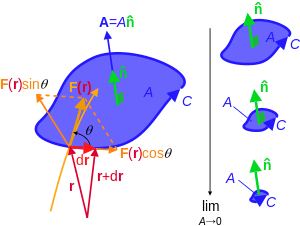
The curl of a vector field F, denoted by curl F, or ∇ × F, or rot F, at a point is defined in terms of its projection onto various lines through the point. If n̂ is any unit vector, the projection of the curl of F onto n̂ is defined to be the limiting value of a closed line integral in a plane orthogonal to n̂ divided by the area enclosed, as the path of integration is contracted around the point.
The curl operator maps continuously differentiable functions f : ℝ3 → ℝ3 to continuous functions g : ℝ3 → ℝ3, and in particular, it maps Ck functions in ℝ3 to Ck−1 functions in ℝ3.
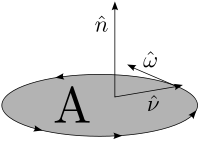
Implicitly, curl is defined:[4][5]
where ∮C F ⋅ dr is a line integral along the boundary of the area in question, and |A| is the magnitude of the area. This equation defines the projection of the curl of F onto n̂, where n̂ is the normal vector to the surface bounded by C; and C is defined via the right-hand rule (see diagram).
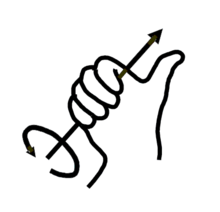
The above formula means that the curl of a vector field is defined as the infinitesimal area density of the circulation of that field. To this definition fit naturally
- the Kelvin–Stokes theorem, as a global formula corresponding to the definition, and
- the following "easy to memorize" definition of the curl in curvilinear orthogonal coordinates, e.g. in Cartesian coordinates, spherical, cylindrical, or even elliptical or parabolic coordinates:
The equation for each component (curl F)k can be obtained by exchanging each occurrence of a subscript 1, 2, 3 in cyclic permutation: 1 → 2, 2 → 3, and 3 → 1 (where the subscripts represent the relevant indices).
If (x1, x2, x3) are the Cartesian coordinates and (u1, u2, u3) are the orthogonal coordinates, then
is the length of the coordinate vector corresponding to ui. The remaining two components of curl result from cyclic permutation of indices: 3,1,2 → 1,2,3 → 2,3,1.
Intuitive interpretation
Suppose the vector field describes the velocity field of a fluid flow (such as a large tank of liquid or gas) and a small ball is located within the fluid or gas (the centre of the ball being fixed at a certain point). If the ball has a rough surface, the fluid flowing past it will make it rotate. The rotation axis (oriented according to the right hand rule) points in the direction of the curl of the field at the centre of the ball, and the angular speed of the rotation is half the magnitude of the curl at this point.[6]
The curl of the vector at any point is given by the rotation of an infinitesimal area in the xy-plane (for z-axis component of the curl), zx-plane (for y-axis component of the curl) and yz-plane (for x-axis component of the curl vector). This can be clearly seen in the examples below.
Usage
In practice, the above definition is rarely used because in virtually all cases, the curl operator can be applied using some set of curvilinear coordinates, for which simpler representations have been derived.
The notation ∇ × F has its origins in the similarities to the 3-dimensional cross product, and it is useful as a mnemonic in Cartesian coordinates if ∇ is taken as a vector differential operator del. Such notation involving operators is common in physics and algebra.
Expanded in 3-dimensional Cartesian coordinates (see Del in cylindrical and spherical coordinates for spherical and cylindrical coordinate representations),∇ × F is, for F composed of [Fx, Fy, Fz]:
where i, j, and k are the unit vectors for the x-, y-, and z-axes, respectively. This expands as follows:[7]
Although expressed in terms of coordinates, the result is invariant under proper rotations of the coordinate axes but the result inverts under reflection.
In a general coordinate system, the curl is given by[8]
where ε denotes the Levi-Civita tensor and ∇ the covariant derivative, the metric tensor is used to lower the index on F, and the Einstein summation convention implies that repeated indices are summed over. In Cartesian coordinate system, the covariant derivative reduces to the partial derivative. Equivalently,
where ek are the coordinate vector fields. Equivalently, using the exterior derivative, the curl can be expressed as:
Here ♭ and ♯ are the musical isomorphisms, and ★ is the Hodge star operator. This formula shows how to calculate the curl of F in any coordinate system, and how to extend the curl to any oriented three-dimensional Riemannian manifold. Since this depends on a choice of orientation, curl is a chiral operation. In other words, if the orientation is reversed, then the direction of the curl is also reversed.
Examples
Example 1
Take the vector field:
For clarity, this can be decomposed as follows:
Its corresponding plot:
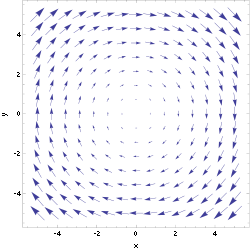
Upon visual inspection, the field can be described as "rotating". If the vectors of the field were to represent a linear force acting on objects present at that point, and an object were to be placed inside the field, the object would start to rotate clockwise around itself. This is true regardless of where the object is placed.
Calculating the curl:
The resulting vector field describing the curl would be uniformly going in the negative z direction. The results of this equation align with what could have been predicted using the right-hand rule using a right-handed coordinate system. Being a uniform vector field, the object described before would have the same rotational intensity regardless of where it was placed.
The plot describing the curl of F:

Example 2
Take the vector field:
Its corresponding plot:
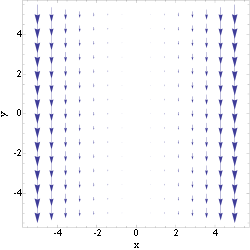
Upon initial inspection, curl existing in this graph would not be obvious. However, taking the object in the previous example, and placing it anywhere on the line x = 3, the force exerted on the right side would be slightly greater than the force exerted on the left, causing it to rotate clockwise. Using the right-hand rule, it can be predicted that the resulting curl would be straight in the negative z direction. Inversely, if placed on x = −3, the object would rotate counterclockwise and the right-hand rule would result in a positive z direction.
Calculating the curl:
As predicted, the curl points in the negative z direction when x is positive and vice versa. In this field, the intensity of rotation would be greater as the object moves away from the plane x = 0.
The plot describing the curl of F:

Descriptive examples
- In a vector field describing the linear velocities of each part of a rotating disk, the curl has the same value at all points.
- Of the four Maxwell's equations, two—Faraday's law and Ampère's law—can be compactly expressed using curl. Faraday's law states that the curl of an electric field is equal to the opposite of the time rate of change of the magnetic field, while Ampère's law relates the curl of the magnetic field to the current and rate of change of the electric field.
Identities
In general curvilinear coordinates (not only in Cartesian coordinates), the curl of a cross product of vector fields v and F can be shown to be
Interchanging the vector field v and ∇ operator, we arrive at the cross product of a vector field with curl of a vector field:
where ∇F is the Feynman subscript notation, which considers only the variation due to the vector field F (i.e., in this case, v is treated as being constant in space).
Another example is the curl of a curl of a vector field. It can be shown that in general coordinates
and this identity defines the vector Laplacian of F, symbolized as ∇2F.
The curl of the gradient of any scalar field φ is always the zero vector field
which follows from the antisymmetry in the definition of the curl, and the symmetry of second derivatives.
If φ is a scalar valued function and F is a vector field, then
Generalizations
The vector calculus operations of grad, curl, and div are most easily generalized in the context of differential forms, which involves a number of steps. In short, they correspond to the derivatives of 0-forms, 1-forms, and 2-forms, respectively. The geometric interpretation of curl as rotation corresponds to identifying bivectors (2-vectors) in 3 dimensions with the special orthogonal Lie algebra (3) of infinitesimal rotations (in coordinates, skew-symmetric 3 × 3 matrices), while representing rotations by vectors corresponds to identifying 1-vectors (equivalently, 2-vectors) and (3), these all being 3-dimensional spaces.
Differential forms
In 3 dimensions, a differential 0-form is simply a function f(x, y, z); a differential 1-form is the following expression:
a differential 2-form is the formal sum:
and a differential 3-form is defined by a single term:
(Here the a-coefficients are real functions; the "wedge products", e.g. dx ∧ dy, can be interpreted as some kind of oriented area elements, dx ∧ dy = −dy ∧ dx, etc.)
The exterior derivative of a k-form in ℝ3 is defined as the (k + 1)-form from above—and in ℝn if, e.g.,
then the exterior derivative d leads to
The exterior derivative of a 1-form is therefore a 2-form, and that of a 2-form is a 3-form. On the other hand, because of the interchangeability of mixed derivatives, e.g. because of
the twofold application of the exterior derivative leads to 0.
Thus, denoting the space of k-forms by Ωk(ℝ3) and the exterior derivative by d one gets a sequence:
Here Ωk(ℝn) is the space of sections of the exterior algebra Λk(ℝn) vector bundle over ℝn, whose dimension is the binomial coefficient (n
k); note that Ωk(ℝ3) = 0 for k > 3 or k < 0. Writing only dimensions, one obtains a row of Pascal's triangle:
- 0 → 1 → 3 → 3 → 1 → 0;
the 1-dimensional fibers correspond to scalar fields, and the 3-dimensional fibers to vector fields, as described below. Modulo suitable identifications, the three nontrivial occurrences of the exterior derivative correspond to grad, curl, and div.
Differential forms and the differential can be defined on any Euclidean space, or indeed any manifold, without any notion of a Riemannian metric. On a Riemannian manifold, or more generally pseudo-Riemannian manifold, k-forms can be identified with k-vector fields (k-forms are k-covector fields, and a pseudo-Riemannian metric gives an isomorphism between vectors and covectors), and on an oriented vector space with a nondegenerate form (an isomorphism between vectors and covectors), there is an isomorphism between k-vectors and (n − k)-vectors; in particular on (the tangent space of) an oriented pseudo-Riemannian manifold. Thus on an oriented pseudo-Riemannian manifold, one can interchange k-forms, k-vector fields, (n − k)-forms, and (n − k)-vector fields; this is known as Hodge duality. Concretely, on ℝ3 this is given by:
- 1-forms and 1-vector fields: the 1-form ax dx + ay dy + az dz corresponds to the vector field (ax, ay, az).
- 1-forms and 2-forms: one replaces dx by the dual quantity dy ∧ dz (i.e., omit dx), and likewise, taking care of orientation: dy corresponds to dz ∧ dx = −dx ∧ dz, and dz corresponds to dx ∧ dy. Thus the form ax dx + ay dy + az dz corresponds to the "dual form" az dx ∧ dy + ay dz ∧ dx + ax dy ∧ dz.
Thus, identifying 0-forms and 3-forms with scalar fields, and 1-forms and 2-forms with vector fields:
- grad takes a scalar field (0-form) to a vector field (1-form);
- curl takes a vector field (1-form) to a pseudovector field (2-form);
- div takes a pseudovector field (2-form) to a pseudoscalar field (3-form)
On the other hand, the fact that d2 = 0 corresponds to the identities
for any scalar field f, and
for any vector field v.
Grad and div generalize to all oriented pseudo-Riemannian manifolds, with the same geometric interpretation, because the spaces of 0-forms and n-forms is always (fiberwise) 1-dimensional and can be identified with scalar fields, while the spaces of 1-forms and (n − 1)-forms are always fiberwise n-dimensional and can be identified with vector fields.
Curl does not generalize in this way to 4 or more dimensions (or down to 2 or fewer dimensions); in 4 dimensions the dimensions are
- 0 → 1 → 4 → 6 → 4 → 1 → 0;
so the curl of a 1-vector field (fiberwise 4-dimensional) is a 2-vector field, which is fiberwise 6-dimensional, one has
which yields a sum of six independent terms, and cannot be identified with a 1-vector field. Nor can one meaningfully go from a 1-vector field to a 2-vector field to a 3-vector field (4 → 6 → 4), as taking the differential twice yields zero (d2 = 0). Thus there is no curl function from vector fields to vector fields in other dimensions arising in this way.
However, one can define a curl of a vector field as a 2-vector field in general, as described below.
Curl geometrically
2-vectors correspond to the exterior power Λ2V; in the presence of an inner product, in coordinates these are the skew-symmetric matrices, which are geometrically considered as the special orthogonal Lie algebra (V) of infinitesimal rotations. This has (n
2) = 1/2n(n − 1) dimensions, and allows one to interpret the differential of a 1-vector field as its infinitesimal rotations. Only in 3 dimensions (or trivially in 0 dimensions) does n = 1/2n(n − 1), which is the most elegant and common case. In 2 dimensions the curl of a vector field is not a vector field but a function, as 2-dimensional rotations are given by an angle (a scalar – an orientation is required to choose whether one counts clockwise or counterclockwise rotations as positive); this is not the div, but is rather perpendicular to it. In 3 dimensions the curl of a vector field is a vector field as is familiar (in 1 and 0 dimensions the curl of a vector field is 0, because there are no non-trivial 2-vectors), while in 4 dimensions the curl of a vector field is, geometrically, at each point an element of the 6-dimensional Lie algebra (4).
The curl of a 3-dimensional vector field which only depends on 2 coordinates (say x and y) is simply a vertical vector field (in the z direction) whose magnitude is the curl of the 2-dimensional vector field, as in the examples on this page.
Considering curl as a 2-vector field (an antisymmetric 2-tensor) has been used to generalize vector calculus and associated physics to higher dimensions.[9]
Inverse
In case the divergence of a vector field V is zero, then there exist vector fields W such that curl(W) = V.
If W is one vector field with curl(W) = V, then adding any gradient vector field grad(f) to W will result in another vector field W + grad(f) such that curl(W + grad(f)) = V as well. This can be summarized by saying that the inverse curl of a three-dimensional vector field can be obtained up to an integration constant and an unknown irrotational field with the Biot–Savart law.
See also
References
- Proceedings of the London Mathematical Society, March 9th, 1871
- Collected works of James MacCullagh
- Earliest Known Uses of Some of the Words of Mathematics tripod.com
- Mathematical methods for physics and engineering, K.F. Riley, M.P. Hobson, S.J. Bence, Cambridge University Press, 2010, ISBN 978-0-521-86153-3
- Vector Analysis (2nd Edition), M.R. Spiegel, S. Lipschutz, D. Spellman, Schaum’s Outlines, McGraw Hill (USA), 2009, ISBN 978-0-07-161545-7
- Gibbs, Josiah Willard; Wilson, Edwin Bidwell (1901), Vector analysis
- Arfken, p. 43.
- Weisstein, Eric W. "Curl". MathWorld.
- Generalizing Cross Products and Maxwell's Equations to Universal Extra Dimensions, A.W. McDavid, C.D. McMullen, 2006
Sources
- Arfken, George B. and Hans J. Weber. Mathematical Methods For Physicists, Academic Press; 6 edition (June 21, 2005). ISBN 978-0-12-059876-2.
- Korn, Granino Arthur and Theresa M. Korn (January 2000). Mathematical Handbook for Scientists and Engineers: Definitions, Theorems, and Formulas for Reference and Review. New York: Dover Publications. pp. 157–160. ISBN 0-486-41147-8.
- Schey, H. M. (1997). Div, Grad, Curl, and All That: An Informal Text on Vector Calculus. New York: Norton. ISBN 0-393-96997-5.
External links
- "Curl", Encyclopedia of Mathematics, EMS Press, 2001 [1994]
- The idea of curl of a vector field
- Curl BetterExplained
- "Divergence and Curl: The Language of Maxwell's Equations, Fluid Flow, and More". 3Blue1Brown. June 21, 2018 – via YouTube.